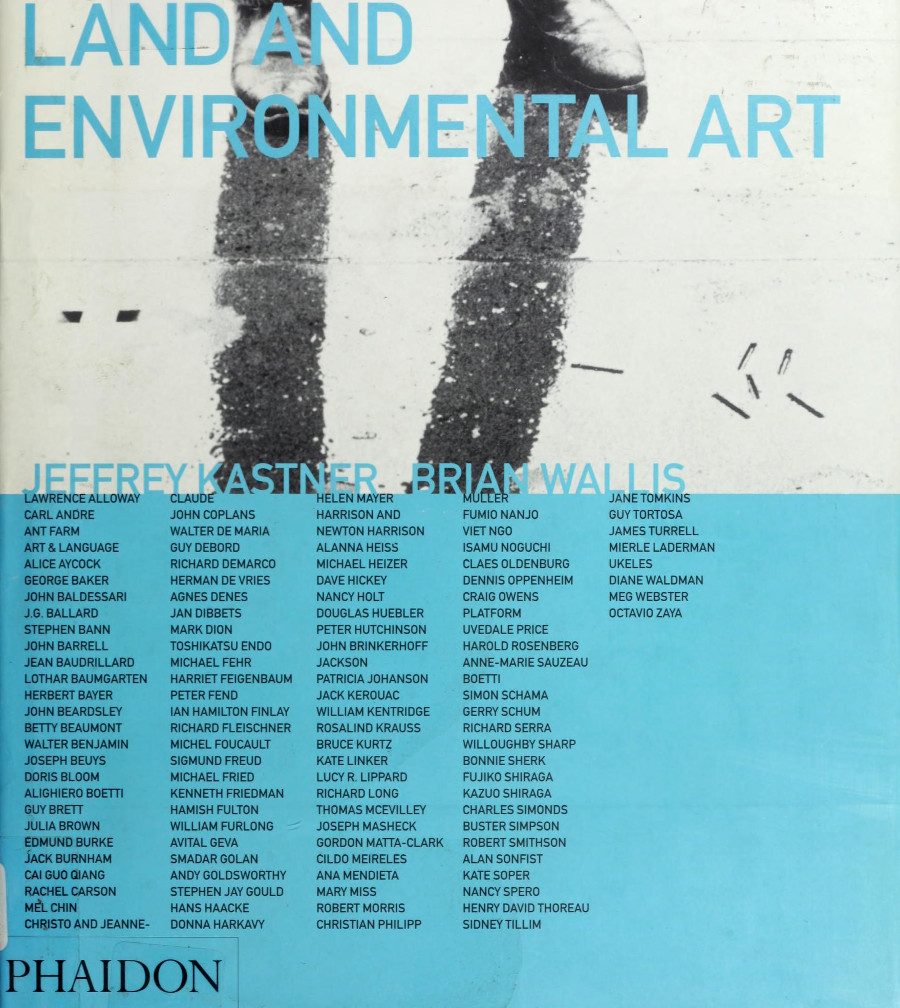Earth Art (1970)
Filed under catalogue | Tags: · art, earth, ecology, land art, nature, sculpture

“With the emergence of land art in the late 1960s, artists began making works inextricably bound to their sites, which became known as “Earthworks.” They worked on location and used the earth itself as canvas or sculptural material, making outdoor gestures—often in distant corners of the world—that were both antimonumental and epic. Because their art evaded the traditional path from cloistered studio to rarefied gallery or museum, the artists often were dependent on photography and the mass media to communicate its very existence.
The Earth Art exhibition—held at the Andrew Dickson White Museum of Art at New York’s Cornell University, in 1969—was the first museum exhibition dedicated to this new way of producing and presenting artworks. Conceived by Willoughby Sharp (1936–2008), an independent curator, publisher, and artist, the exhibition presented site-specific installations by nine artists: Jan Dibbets from the Netherlands, Hans Haacke and Günther Uecker from Germany, Richard Long from Great Britain, David Medalla from the Philippines, and Neil Jenny, Robert Morris, Dennis Oppenheim, and Robert Smithson from the United States. Initially twelve artists were invited: Michael Heizer and Walter de Maria briefly exhibited in the show but were not mentioned in the catalogue, which was published a year later. Carl Andre was also invited but ultimately declined to participate.
Most of the participating artists were on site for about a week in late January/early February of 1969 to make new pieces for the exhibition with the help of students from Cornell University, including Gordon Matta-Clark and Louise Lawler, graduates of the College of Architecture, Art, and Planning. Medalla sent installation instructions for his piece by mail, while Morris had to phone his in—he could not make it to Ithaca because of a blizzard.
Installed inside the A. D. White Museum and scattered around the Cornell campus and the surrounding Ithaca area, the commissioned pieces sought to eschew the commodity status of the art object and to question the role of institutions. The dissolution of boundaries—between object and context, between different mediums, and between the work of art and its documentation—was a hallmark of the art of the time, reflecting 1960s counterculture more broadly. It is at this intersection—where art meets life and art turns into activism—that the influence of the 1960s earth artists has perhaps had the most significant impact on a current generation of artists working on issues related to ecology.
The exhibition catalogue includes a foreword by Thomas W. Leavitt (1930–2010), then the director of the A. D. White Museum of Art; essays by Sharp and William C. Lipke, then professor of art history at Cornell University; artist biographies; transcripted excerpts from a symposium on earth art held at Cornell on February 6, 1969; and more than forty black-and-white photographs.” (Source)
Edited by Nita Jager
Publisher Cornell University, New York, 1970
[81] pages
via Cornell University Library
Images
Video interviews with Willoughby Sharp and Dennis Oppenheim about the exhibition, 2008, 20 min
PDF (25 MB)
View online (Hathi Trust, updated on 2019-4-10)
Jeffrey Kastner, Brian Wallis (eds.): Land and Environmental Art (1998)
Filed under book | Tags: · aesthetics, architecture, art, art history, art theory, ecology, environment, land art, landscape, nature, sculpture

“The traditional landscape genre was radically transformed in the 1960s when many artists stopped merely representing the land and made their mark directly in the environment. Drawn by the vast uncultivated spaces of the desert and mountain as well as post-industrial wastelands, artists such as Michael Heizer, Nancy Holt and Robert Smithson moved the earth to create colossal primal symbols. Others punctuated the horizon with man-made signposts, such as Christo’s Running Fence or Walter de Maria’s Lightning Field. Journeys became works of art for Richard Long while Dennis Oppenheim and Ana Mendieta immersed their bodies in the contours of the land.
This book traces early developments to the present day, as artists are exploring eco-systems and the interface between industrial, urban and rural cultures.”
Edited by Jeffrey Kastner
Survey by Brian Wallis
Publisher Phaidon Press, 1998
ISBN 0714835145, 9780714835143
304 pages
Review: Boettger (CAA.Reviews, 1999).
PDF (117 MB, no OCR)
For more on land art see Monoskop wiki (includes a select bibliography and collection of links to online documentation of the works by early land artists).
Comment (0)Robert Smithson: The Collected Writings (1979/1996)
Filed under book | Tags: · art, art criticism, art theory, earth, ecology, entropy, land art, landscape, language, mapping, monument, non-place, time

“Since the 1979 publication of The Writings of Robert Smithson, Robert Smithson’s significance as a spokesman for a generation of artists has been widely acknowledged and the importance of his thinking to contemporary artists and art critics continues to grow. In addition to a new introduction by Jack Flam, The Collected Writings includes previously unpublished essays by Smithson and gathers hard-to-find articles, interviews, and photographs. Together these provide a full picture of his wide-ranging views on art and culture.”
First published as The Writings of Robert Smithson, New York University Press, 1979.
Revised and Expanded edition
Edited, with an Introduction by Jack Flam
Publisher University of California Press, 1996
ISBN 0520203852, 9780520203853
385 pages
via dhr
PDF (62 MB, no OCR)
PDF (18 MB, OCR, updated on 2016-12-15)

